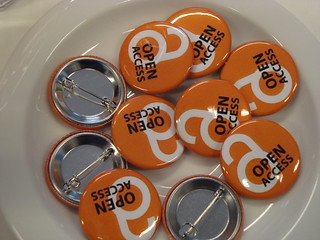Opening the Access to Scholarly Research

Open Access promo buttons - photo by biblioteekje, on Flickr
I was listening recently to an episode of The Chronicle's Tech Therapy podcast on the "Moral Imperative" for Open Access to scholarly research featuring David Parry. He is an Assistant Professor of emerging media and communications at the University of Texas at Dallas and his main point was that scholars have an obligation to publish their research in journals that make free copies available online.
This is a topic that I am interested in and I agree with Parry. This is also a hot and debatable topic tight now. Unfortunately, it was the suicide of Aaron Swartz after he was being prosecuted for trying to free such research that brought it to many mainstream news outlets.
"Information is power," Swartz wrote. "But like all power, there are those who want to keep it for themselves." He had made unauthorized downloads of more than four million articles from JSTOR and the federal indictment against him said that he did it in order to then upload them to the Internet and make them available for free.
His approach was radical and was compared on news outlets to Wikleaks. The tragedy in his case was that even though the civil complaints against him were dropped and he had returned all the downloaded data, the case was still being pursued.
David Parry calls sites like JSTOR "knowledge cartels."
The term "open" and open access (OA) has a number of meanings. According to Wikipedia (itself an open site), open access can be defined as "the practice of providing unrestricted access via the Internet to peer-reviewed scholarly journal articles. There are a growing number of theses, scholarly monographs, articles and book chapters that are provided with open access to all.
There are two degrees of open access: gratis OA meaning no-cost online access, and libre OA which is like gratis but with some additional usage rights.
Similarly, we use the term "open content" with materials available online where the author(s) gives the right to modify the work and reuse it. Most of us went through school learning to use content intact and to associate it with an author(s).
You might be familiar with Creative Commons licenses that can be used to make content accessible and yet to specify usage rights (such as attribution or non-commercial usage). This blog uses a Attribution-NonCommercial-ShareAlike Creative Commons license for the content.
The open access concept was pushed forward at a rapid pace by the Internet, and in education it was pushed by its extension into learning objects and other resources used in online learning.
Scholarly publishing, much like the music and film industry and traditional publishing, has resisted open access, and may very well find that resistance to be why it will disappear.
You can listen to the Tech Therapy podcast on The Chronicle site or subscribe to it with iTunes.
Comments
No comments